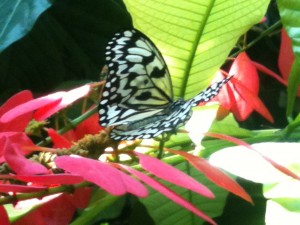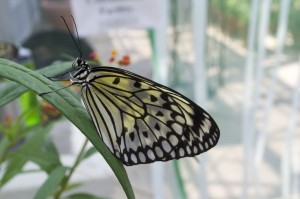Every day after dinner, my mother would hand me a White Rabbit Creamy Candy. As she plunked the candy on the table, she would always make sure to offer me some wise words of advice: “Make sure to eat the candy, because your breath stinks.”

Delicious White Rabbit Creamy Candy wrapped in rice paper (Photo credit: http://www.alohagourmet.com/white-rabbit-candy)
Despite my mother’s brutal honesty, this sweet, milk-flavored candy was a favorite of mine. What made this candy so delicious was not the actual candy itself, which I found too sweet, but the thin sheet of rice paper wrapped around it. I would meticulously pick apart the translucent paper until I had a neat pile of rice paper flakes sitting next to my now, very naked piece of candy. The rice paper had a slightly vanilla flavor from the candy residue, and after a couple of chews, the texture felt very much like congee. It was a tasty treat I looked forward to every night.
Named for its similar appearance to rice paper, the Idea leuconoe butterfly is a part of the Lepidoptera order, and is also known as the Rice Paper butterfly. They have translucent cream-colored wings with black markings and veination, and look so elegant whilst flying, that their style of flying has been likened to that of paper floating in the sky. You can see a video of them fluttering here.
Beware though! The Rice Paper butterfly’s similarity to rice paper only gets as far as its outward appearance. Unlike the tasty dessert that masked my bad breath, I. leuconoe has an extremely bitter taste. Not only are these butterflies undesirable to eat, but pyrrolizidine alkaloid, one of the chemicals that contributes to their unpalatable taste, is actually toxic to many vertebrates.
Like other species in the subfamily Danainae (milkweed butterflies), the Rice Paper butterfly also lays its eggs on milkweed plants. Milkweed serves not only as the main source of food for the hatched caterpillars, but it also contains cardiac glycoside, which is a defense toxin that deters predators from munching on it. Over time, the I. leuconoe caterpillar will retain a lot of cardiac glycoside. Then, once it turns into a butterfly, it will accumulate pyrrolizidine alkaloids from drinking nectar. Borrowed from their diet, these toxins in their bodies give them a bitter flavor that they also use as a defense mechanism against predators.
Pyrrolizidine alkaloids also play an important role in the mating process. When female and male Rice Paper butterflies are ready to mate, the male will (I’d like to think, chivalrously) go first and secrete this chemical, along with others, as a pheromone. Releasing this pheromone onto the female’s antennae through his abdomen hairpencils signals his desire to mate with her. After successful copulation, the female will lay her eggs on a milkweed plant, and this heavily protected life cycle will begin again.

A Rice Paper butterfly taken at the Cockrell Butterfly Center, Houston Museum of Natural Science (Photo Source: Me!)
The next time you see a Rice Paper butterfly, remember, you are what you eat. Although it may resemble tasty butterfly-shaped rice paper, eating an I. leuconoe butterfly has more dangerous effects than chewing on a White Rabbit Creamy Candy does. I highly recommend you try a piece of the candy though, and perhaps you can snack on it while you hunt for Rice Paper butterflies!

